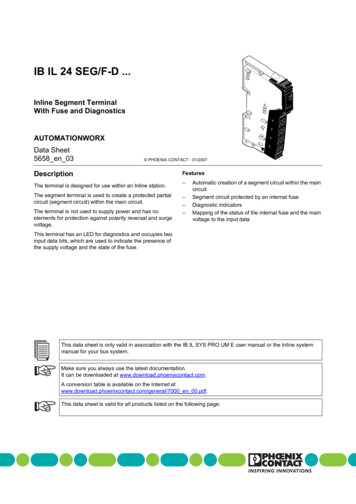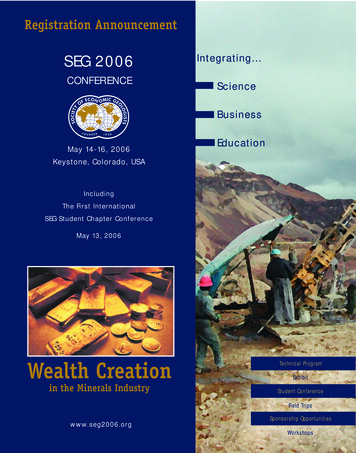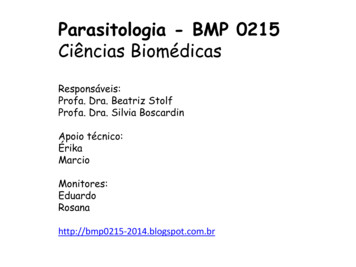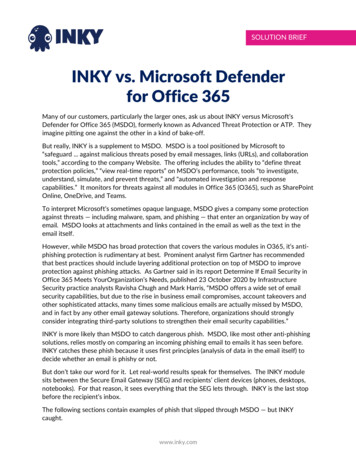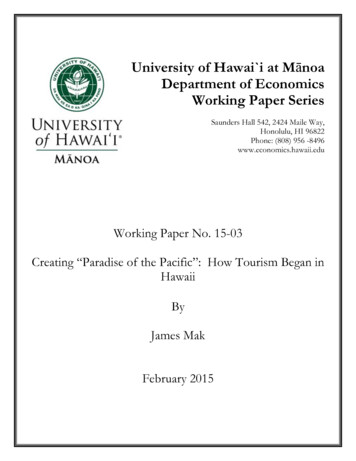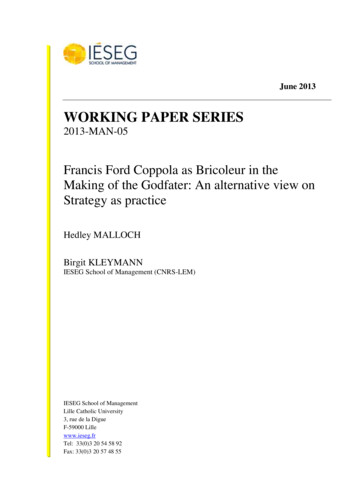
Transcription
June 2013WORKING PAPER SERIES2013-MAN-05Francis Ford Coppola as Bricoleur in theMaking of the Godfater: An alternative view onStrategy as practiceHedley MALLOCHBirgit KLEYMANNIESEG School of Management (CNRS-LEM)IESEG School of ManagementLille Catholic University3, rue de la DigueF-59000 Lillewww.ieseg.frTel: 33(0)3 20 54 58 92Fax: 33(0)3 20 57 48 55
IESEG Working Paper Series 2013-MAN-05FRANCIS FORD COPPOLA AS BRICOLEUR INTHE MAKING OF THEGODFATHER: AN ALTERNATIVE VIEW ON STRATEGY AS PRACTICEHEDLEY MALLOCH AND BIRGIT KLEYMANNABSTRACTThis paper analyses Francis Ford Coppola’s account of his making of The Godfather, one ofthe most successful movies in history, in an attempt to understand the role of bricolage in thestrategy process. Our theoretical framework is Pettigrew’s (1990, Pettigrew, 1992, Pettigrewet al., 2001) process view of strategy development and Stacey’s (2000, Stacey et al., 2000)‘bottom-up- teleology’. The contextual variables in which bricolage was enacted were: thehistory of the project plus four of Caves’ (2000) properties of the creative arts; namely the‘nobody knows’ property, art for art’s sake, the motley crew property and the O-ring theory ofproduction. Coppola’s account of how the movie project was crafted was transcribed usingNvivo and analysed using content analysis. The authors attempt to show that Coppola can beconsidered a bricoleur in the sense used by Lévi-Strauss (1962) rather than more recentinterpretations.Coppola as bricoleur used human resource acquisition strategy; humanresource development; and capability development and acquisition of resources as hisrepertoire of tools and resources to fashion his masterpiece.INTRODUCTION AND OVERVIEWThis is the story of how The Godfather, one of the most successful Hollywood productionsever made was crafted, very much against the odds, out of a vision and less-than-perfectcircumstances. We argue that this story is a useful case study on strategy as practice andprocess.1
IESEG Working Paper Series 2013-MAN-05Coppola’s The Godfather can be regarded as a case study of an outstanding commercial,strategic and cultural success which revived Hollywood (Thompson and Bordwell, 1994;pp.710-714). In the year of its release it took three times as much at the US box office as itsnearest competitor. Finler estimated that it cost 6 million to make, but took 86.3 million atthe box office (1988, p.125). Later estimates put the gross take of all three movies in TheGodfather series at between 800 million (Lewis, 1997, p.156) to one billion dollars (Browne,2000, p.1).Its commercial success was mirrored in its artistic achievements. It won three Oscars for bestfilm, best actor, and best screenplay (Finler, 1988, p.167) and it has been described as one ‘ofthe monuments on the landscape of American cinema’ and ‘one of the enduring works ofAmerican cinema.’ (Browne, 2000, p.1). It has been commended for the very high level ofcraft shown in its production: set design, costumes, lighting, cinematography, sound, music,editing all providing ‘an extraordinary level of sensuous delight in cinematic design andpresentation’ (Browne, 2000, p.2). Forty years after its release The American Film Institutestill ranks The Godfather as the third-best movie of all time (American Film Institute, 2010).It occupies an important place in the strategic development of the movie industry in that itwas the first of the ‘series’ movies, in which historically linked characters and problems arerevisited in different contexts (Thompson and Bordwell, 1994, pp.714-715); or based onproprietary characters and repeatable titles.These, coupled with tight legal protection,‘helped Hollywood to reap record profits’ (Altman, 1999, p.117).One of Coppola’scollaborators on The Godfather, and a personal friend of Coppola, was George Lucas wholater produced the Star Wars and Indiana Jones series, both good examples of the seriesformat.2
IESEG Working Paper Series 2013-MAN-05WHY THE STUDY IS IMPORTANTShamsie et al point out (2009, p.1440) that while the literature on strategy is replete withexhortations to management to develop the capabilities necessary to manage a turbulentenvironment, most of it stops well short of offering specific operational advice about theactivities and processes necessary to achieve them (Priem and Butler, 2001). Existing studiesof the movie-making industry are no exception.Building on the works of Champoux (1999, Champoux, 2001a, Champoux, 2001b), the use offeature films in management research has been highlighted by Buchanan and Huczynski(2004) who argue that feature film can be used as a fruitful case tool for teaching coreprinciples of Organisation Theory such as process theorising and narrative analysis. Inanother, related study (Huczynski and Buchanan, 2004), they go more into pedagogical detailsof using films as a case study. Whereas these articles look at the content of the movies andhow it can be used for teaching and/or theorising, we wish to suggest that the making of it isin itself a complex strategic process that holds valuable insights into the strategising process.For example DeFillipi and Arthur (1998) state that filmmakers need to develop competenciesin key areas such as recruitment and ‘the management of complexities spanning coordinationof cast, production crews, elaborate sets and sophisticated technologies’ noting that ‘theseproject specific, knowledge-based competencies can be an important source of competitiveadvantage’ (1998, p.126), they do not disclose much detailed information as to what specificmanagement actions need to be carried out to achieve these highly desirable outcomes. Onthe other hand Coppola offers a relatively open and vivid account of how he managed thespecific problems which confronted him to achieve strategic success.We start with a review of the importance of process thinking in understanding management,before moving to a description of the Hollywood movie industry background and the part3
IESEG Working Paper Series 2013-MAN-05played by The Godfather in its turnaround. Next we will turn to a brief description of how thefilm was made. An account of our methodology is followed by how the analysis of theCoppola’s audio-commentary of digitally re-mastered version of the DVD released in 2007shows not only bricolage in action, but one marked by Coppola’s very distinctive vision, onewhich is not shaped a priori, but is formed as the project develops. We then continue theanalysis to provide examples of Coppola as a bricoleur.STRATEGISING: CONTEXT AND PROCESS.In this paper, we follow Pettigrew’s view of processes as “A sequence of individual andcollective events, actions, and activities unfolding over time in context” (1997, p.338). Thecontext in which the movie was crafted included The history of the project Four of Caves’ (2000) economic properties of the creative arts; namely, the nobodyknows rule, the O-ring theory of production, the motley crew, and art for art’s sake. Coppola’s evolving vision of the filmThe making of The Godfather is a good example of how strategy frequently emerges throughwhat can be called a moderately managed process. Pettigrew has argued that ‘[p]ower,chance, opportunism, accident are as influential in shaping outcomes as are design, negotiatedagreements and master- plans’ (1990, p.268). Importantly for the present study, the context isvery much based on, and evolving with, the vision. Context is ‘about constellations of forcesshaping the character of the process and its outcome’ (Pettigrew, 1990). In other words, it isan integral part of the process dynamics.While they are difficult to catch with ‘traditional’, quantitative empirical tools, emergentstrategies and what has been called “bottom-up teleology” (Stacey et al., 2000) are powerfulmetaphors to understand “how things get done” in organisations at large, and at project level.4
IESEG Working Paper Series 2013-MAN-05The focus is less on managerial planning. Instead, organisations are conceptualised as opensystems (Scott, 1991) which are governed by intervening at “leverage points” (Meadows,1999) in order to direct the process of their development. In other words, our perspective of‘governed emergence’ is somewhere between the traditional planning view on strategicmanagement and those theories that see organisational development as the result ofautopoiesis (Bakken and Hernes, 2003, Brandhoff, 2009, Letiche, 2000, Seidl and Becker,2006, Stacey, 2000, Stacey et al., 2000) with rather little emphasis on the influence ofindividual managers and their vision - however blurred - of an outcome.In his very interesting outline of the importance of process philosophy for the understandingof strategic management, Styhre (2002) sees process as ‘turning-into-something’, which ofcourse requires us to re-conceptualise the notion of strategy itself. It is here that the notion ofthe strategist as a ‘bricoleur’, on which we will elaborate further down, becomes helpful. Wedecided to approach our case as a ‘process narrative’ (Van de Ven and Poole, 1995), lookingat a sequence of events in which a structure – in this case, an initially rather loosely definedand fairly unclear movie project - unfolds.It is important here to stress that this is not about improvisation as a (short-term) deviationfrom an existing plan (as e.g. described in Leybourne (2006) or Miner et al (2001a) ). Whatwe see in Coppola’s work is not some sort of (partial) deviation from, or amendment to, anexisting plan or procedure. Instead, we are witnessing the very process of creation itself,which does contain, within it, some degree of improvisation to deal with e.g. financial andtime constraints, opposition from the studio, etc. But these instances of improvisation happenwithin, and subordinate to, the larger context of a creative process that works from the bottomup, creating something that is only emerging through the process of creation itself.We hope to make this clear by our discussion on the content. We then focus on the key5
IESEG Working Paper Series 2013-MAN-05capabilities, or processes, used by Coppola, that depended upon bricolage - These are:network bricolage; improvisation and bricolage; and capability acquisition by bricolage.These are not the only capabilities he displayed. Many of his other competences such as hisacute sense of timing, his ability to manage difficult co-workers, and his negotiating skillswere critical to the strategising process, but they are outside the scope of this paper.We would like to suggest that Coppola is very much a bricoleur in the sense of Duymedjianand Rüling (2010) who describe the archetype of the bricoleur in organisation management.taking up a concept originally described by the anthropologist Claude Lévi-Strauss (1962).Several features of the bricoleur are found in Coppola’s way of creating – or rather, crafting his movie production. These are: his work is a flowing process, more a dialogue with the external world than a singleminded following of a pre-established plan; he relies on a ‘stock’ of tools and resources and a ‘repertoire’ of techniques, which hethen creatively combines and uses to improvise; the film is the result of vision as much as improvisation and crafty use of the ‘stock’and ‘repertoire’.Much of his stock and repertoire is human. As a bricoleur, his view on things is slightlyidiosyncratic, which brings him into tensions with other stakeholders in the project (notablythe studio). Also, as a typical bricoleur, Coppola makes use of ‘resources’ and ‘repertoires’ hehas at hand.But in contrast to the bricoleur described by Duymedjian and Rüling (2010), Coppola is anentrepreneurial and visionary bricoleur. His bricolage is the result of an individual effort (thisis much closer to Lévi-Strauss’ original concept than the more collective view Duymedjian6
IESEG Working Paper Series 2013-MAN-05and Rüling take, maybe as a result of the contemporary Zeitgeist which tends to celebrate thecollective - the “team”- over than the individual. But Coppola’s effort is entrepreneurial andvisionary, and in that it is first and foremost solitary. The vision is his, and it is at firstdifficult to convey to other stakeholders. He follows it, improvising with resources at hand,and compromising with given constraints (eg.finances and time limits).THE CONTEXT OF THE GODFATHERThe History of the ProjectIn the early 1970s Hollywood was in crisis: few films released made money (Lewis, 2000,p.23). Production costs were out of control with huge amounts invested in epic movies withlittle public appeal. The Godfather came at a time when Hollywood had become ‘a bounteouspoultry yard for ten-ton turkeys’(Caves, 2000, p.138). In 1968, Paramount Studios, part ofthe Gulf and Western conglomerate, had bought the script of Mario Puzo’s then little-knownnovel ‘The Godfather’ (1969). It was seen as a low budget project of no great merit. Theculture of Paramount at the time has been described as ‘powerful and repressive’ (Browne,2000, p.11).At about the same time, Francis Ford Coppola’s independent film production company,American Zeotrope, failed leaving Coppola with personal debts of 600,000. Paramountapproached Coppola, only after other directors had turned it down, seeing the script as a storywhich glorified crime and having a ‘potentially incendiary ethnic character’ (Lewis, 2000,p.27). Coppola, whom Browne describes as ‘an independent genius’, (2000, p.11) initiallydismissed the script as ‘a hunk of trash’, but agreed to manage the project for financialreasons. Nevertheless, as Coppola read the script another story began to emerge; that of afather possessed of three key gifts: cunning, ruthlessness and kindness. He has three sons,7
IESEG Working Paper Series 2013-MAN-05each of whom has only one of these qualities – but not the other two. For Coppola TheGodfather is about the problems of succession and leadership at a time of change, and ametaphor for American capitalism. He re-writes Puzo’s initial script to reflect these themes.Further, Paramount’s plan had been to set the movie in the 1970s, in Kansas City. Coppola’svision for the movie required that the story be set in New York immediately after the SecondWorld War, with matching locations, sets, wardrobe, cinematographic equipment, fittings,music, and casting. The movie’s budget was increased from two to six million dollars,precipitating a series of bitter rows between Paramount and Coppola, and ensuring that costcontrol of the project was a central issue for Paramount.A further issue between them was Coppola’s choice of Marlon Brando and Al Pacino in thekey roles. Initially Paramount rejected both, preferring stars with known box-office appeal,and who, unlike Brando, would have been easy to manage. Shooting was delayed whilst thearguments are concluded.Coppola prevailed, but at a cost. Paramount lost confidence inhim, responding in two ways: by increasing close supervision of Coppola on set, and byseeking to replace him. For much of the shooting Coppola was working in fear of immediatedismissal, and with a technical crew who had little confidence in his abilities. His problemswere compounded by the eccentric behavior on the set of key actors.Another problem was managing the growing interest taken by front organisations for theMafia in the production of the film, with lobbying, demonstrations and public meetings takingplace. Paramount’s settlement with them included script changes and acceptance of Mafiamembers for non-speaking parts. Arguments continued between Coppola and Paramountpost-production with disputes about the length and content of the film. One result of theseevents was bitter personal enmities between Coppola and members of Paramountmanagement.8
IESEG Working Paper Series 2013-MAN-05The Nobody Knows PropertyThe film industry has its own institutional features, embedded in its economics and in itslabour and product markets, which shape and constrain its own strategies (Caves, 2000). Oneof the most important of these is, in William Goldman’s throwaway line, that ‘nobody knowsanything’ (Goldman, 1983). Whether measured by box-office takings or profits, successes infilm-making cannot be predicted (Pokorny and Sedgwick, 2009, De Vany and Walls, 2004,Walls, 2005). The film is an experience good. Consumers’ satisfaction is a subjectiveprocess which cannot be determined in advance. Some studies have attempted to explain thestrategies contributing to success in the movie industry (Pokorny and Sedgwick, 2009,Shamsie et al., 2009), but these analyses are retrospective. Patterns of success may bediscerned in the industry’s financial history, but at the time of the movie’s realisation then‘nobody knows’. One effect of the nobody knows property is to generate uncertainty at alllevels, but especially between the client (the studio) and the project manager (the director).Since neither can define the success or failure, the management of the project and its finaloutcome is liable to be contested.Art for Art’s SakeMembers of the film crew (actors, directors, photographers, designers, make-up, writers, etc.)care about the quality of the product (Caves, 2000). They are concerned to show originality,creativity, finesse, technical excellence and faithful rendition features which may not bevalued by the customer, and which will all cost money. The human characteristics whichelicit the production of these features are imagination and passion. These can make the artistof whatever hue a difficult person with whom to reach compromises, technical or social. Theart for art sake’s property (Caves, 2000, p.4) has a number of consequences. Artists can bedifficult to integrate into a team; similarly they can be reluctant to appreciate the cost9
IESEG Working Paper Series 2013-MAN-05implications of their actions. To the extent to which the artist considers that their imaginationand passion should be given free rein, and that they have the power to force that view, thenthey can be difficult for the director to manage.The Motley CrewThe film production team is a motley crew (Caves, 2000, p.4). Examination of the credits listshown at the end of any modern movie shows the huge range of specialist functionaries andtechnicians which need to be integrated when making a modern movie. Many of thesepersonnel are imbued with the notion of art for arts’ sake, rooted in different skills andaesthetics, with conflicting priorities and preferences brought to the director for co-ordination(Caves, 2000, p.5).Yet for the film to succeed all these inputs have to function insynchronisation and in a mutually supportive manner.The O-Ring Theory of ProductionMovie making is a multiplicative production function where every input must function to aminimum level of efficiency if a good movie is to be produced. This is the O-ring theory ofproduction, called after the failure of an O-ring which caused the Challenger disaster in 1986(Kremer, 1993).A complex project costing millions of dollars failed, killing sevenastronauts, because of a malfunctioning in a part costing a few dollars. As Caves notes theneed for an acceptable level of performance for all employees has implications for selectingand managing team members (2000, p.6)Coppola’s Vision for the MovieCoppola was initially unimpressed with Puzo’s script, but saw within it the seeds a dramaabout the problems of succession in a family firm at a time of change. Part of his vision was aconcern for accuracy. The film had to be set in New York and Sicily in 1945 and the actors,10
IESEG Working Paper Series 2013-MAN-05locations, costumes, set design, equipment (houses and cars) and sound had to convey thissense of time, place and ambiance. This is Coppola’s expression of art for art’s sake and asdirector, or project manager, it falls on him to make this vision.We conceive of itsmanufacture as the production of aesthetics – the sense of light, colour, appearance, touch,acoustics, the spoken word, feel – to be conveyed to the customer (Garvin, 1988). Of coursemuch of this comes with a price-tag which involves Coppola in a series of battles withParamount over casting, music and locations. He eventually secures an increase in budget to 6 million, but this notwithstanding the film has to be made in a resource penurious context.METHODOLOGYA full transcription was made of Coppola’s audio-commentary on the making of TheGodfather included on the referenced DVD (Coppola, 2007). This produced a script of some19,000 words which was then coded for items of interest using Nvivo8. Over the yearsCoppola has given a number of other accounts of the making of the film and these wereconsulted, as were relevant secondary sources on the making of the movie and of the filmindustry.Reliability was attempted through triangulation by data source (Denzin and Lincoln, 2005).Coppola’s account is by and large supported by the secondary sources with the exception oftwo items. The first relates to the Mafia’s attempts to influence the making of the movie.Mafia intervention succeeded in minor script alterations (Lewis, 2000, p.32). On this matterCoppola is silent, consequently his account may understate the amount of external pressure hewas under whilst making the film.The second relates to an argument between Coppola and Evans, Paramount’s Head ofProduction as to which of them was actually responsible for the finished version. Accordingto Lewis (1997) throughout the production Evans posed a series of challenges to Coppola’s11
IESEG Working Paper Series 2013-MAN-05control of the picture on casting choices, lighting, length, but when its success became clearEvans was happy to take the credit.Independent opinion seems to favour Coppola.According to Albert Ruddy (the film’s first-line producer employed by Paramount) it wasCoppola who was responsible. “But the final cut was Francis’s cut – frame for frame”(Lebo, 1997, p.198).PRESENTATION OF DATAA content analysis of Coppola’s account revealed 186 pieces of relevant data in 34 codes. Onfirst inspection there appeared to be little overall pattern but when certain codes are combinedinto meta-categories, a clearer picture presents itself. This is shown on Table 1: ContentAnalysis by Meta-Categories of Coppola’s Commentary on the Making of The ----------------Insert Table 1 ------------As can be seen his account is dominated by human resource acquisition, his own humanresource development capabilities, his other capabilities and resource management. Thesefour meta-categories account for fifty-five per cent of the coded data. Within these four metacategories there were two types of strategising, behaviour. These were those behaviours: Which were to some extent dependent on bricolage in the Lévi-Strauss (1962) senseof the word; These can be categorised as network bricolage, improvisation throughbricolage, human resource acquisition with bricolage in mind; bricolage as capabilityacquisition and the re-cycling and borrowing of physical resources and ideas. Concerned with the display of personal competences.These include: buildingaffective relationships, managing difficult co-workers, recognition of fellow workers,12
IESEG Working Paper Series 2013-MAN-05industry specific knowledge, dispute resolution, timing, and managing his own senseof insecurity.We now turn to a discussion of his activities as a bricoleur.NETWORK BRICOLAGECoppola’s account is noteworthy for its numerous (n 18) references to the use of family andfriends. He knows and is friendly with most of the actors , having worked with them on otherprojects. His life-long friend, George Lucas, is employed as film editor.His father is themusic director for the movie, composing and conducting the scores. His sister Talia has a roleas Connie, the daughter of Don Corleone, and numerous Coppola children have parts asextras. As well as free labour they are frequently a source of ideas. In The Godfather 3 hegives an important role to Sophia, his sister. It is known from other accounts of Coppola’swork that he has used his family on other projects, for example on Apocalypse Now (Alvarezet al., 2004).There were two reasons he included his family. The first is that his family was important tohim and by engaging them in the shooting of the film, and then this would help his family tobond. The making of a movie afforded an opportunity for a summer school camp for thefamily.“When I was going away on location for more than a week or two, I would just pull the kidsout of school and take the family. I think it’s very hard to encourage kids and have thatrelationship with them if you’re off on business trips, making movies. So if you enjoy allthese activities as a creative family, everyone will have a field they’re good at and someconfidence to pursue it.” (Beard, 2011).A second reason was that some women of his family were interested in a career in film at atime when it was much harder for them gain a foothold on the career ladder. He used his13
IESEG Working Paper Series 2013-MAN-05position as Director to sponsor them. So in this case the bricoleur is using the project tosupport his family, a reminder that for the bricoleur the boundaries between work and nonwork roles are both blurred and permeable (Baker and Nelson, 2005, p.348).Finallybricoleurs routinely test conventional limitations – in this case about traditional assumptionsabout the boundary between work and non-work (Baker and Nelson, 2005, p.335).IMPROVISATION AS BRICOLAGENot all improvisation is bricolage, but there are numerous examples of Coppola and his crewimprovising their way out of problem, or taking advantage of opportunities, by bricolage. Wedefine improvisation as ‘the degree to which composition and execution converge in time’(Miner et al., 2001b, p.305, Moorman and Miner, 1998, p.698).Details of some keyexamples are given on Table 2: Improvisation and Bricolage in The -----------------Insert Table 2 ------------The scene with the cat is an exception, because it is not forced by a problem; Coppola istaking advantage of an opportunity. Yet in the remaining three of these scenes Coppola canbe seen as having to manage problems embedded in a constellation of contextual factors suchas art for art’s sake, the motley crew, the O-ring theory of production, and processualconsiderations such as managing difficult actors and co-workers. Here we can see thatCoppola is engaging in an interactive and re-iterative way to realise his vision, withinlimitations which have forced him to abandon whatever pre-conceived plans he had. He hasto learn by trial and error, by improvising, which forces bricolage since the resources neededby Coppola – a memory for Montana, knowledge of Italian for Pacino, and acted terror from14
IESEG Working Paper Series 2013-MAN-05the child – cannot be acquired on the spot. By means of a bricolage, making the best of whatthere is to hand, he solves these problems of resource parsimony. Yet what is remarkablehere is that the improvisation process turns actors’ deficiencies into strengths.This incident demonstrates that improvisation is not an inferior way of strategising.Improvised scenes such as these made by bricolage produce resources which are valuable,rare, very difficult to imitate, and which depend upon some extremely complex intangiblelinkages, one of which is Coppola’s sense of intuition. These scenes, and the competence tomake them, would appear to satisfy the tests for competitive capability (Barney, 1991). Thefindings in this case support the growing body of evidence which suggests the capacity tomanage improvisation (whether by means of bricolage or not) is a key strategic capability,notably in resource-hungry environments - see for example Radjou et al. (2012, pp.100-105).HUMAN RESOURCE ACQUISITION AND BRICOLAGEBricolage starts with bricoleur’s access to resources. So whilst recruitment in not necessarilypart of the bricoleur’s repertoire, the human resources that can be acquired as stock willinfluence the quality of work whether it is made by bricolage or not. Coppola is well awareof this. It is clear that for Coppola recruitment is the key HRM task. For him, it is ‘the headof the river’ from which everything else flows (Farkas and Wetlaufer, 1996, p.116). Hewishes to work with people with whom he can co-create. We define co-creation as “theprocess by which repeated and iterative interaction between individuals and/or organisationssignificantly or exclusively contribute to shaping the emergence and/or final shape of aproduct, or a social phenomenon such as institutions, concepts, or ideas". Co-creation elicits asearch for co-bricoleurs. This can be seen in his comments on why he likes working withItalian actors:“I really loved working with the Italian actors. They worked in a way very different from15
IESEG Working Paper Series 2013-MAN-05what I was used to with American actors. American actors, you suffer with them on the wayto the performance, whereas the Italian actors always came with something already workedout. If you don’t like what they have worked out, then they’ll work out something else.”(Coppola, 2007; 01:58:25).One of his co-bricoleurs is Brando. It is Brando who defines the physical appearance of DonCorleone, the Godfather, through a process of bricolage. Here Coppola talks about Brando’sfirst screen test:“He must have been 47 and in a Japanese robe, he looked very impressive. I looked at himwith his ponytail and said, ‘My God, how is he ever going to play a Mafia chieftain?’ It wasfunny. I hardly talked.
Godfather series at between 800 million (Lewis, 1997, p.156) to one billion dollars (Browne, 2000, p.1). Its commercial success was mirrored in its artistic achievements. It won three Oscars for best film, best actor, and best screenplay (Finler, 1988, p.167) and it has been described as one 'of
